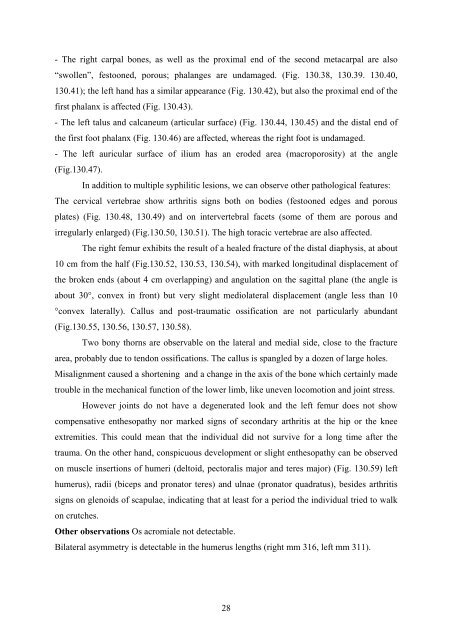Anthropological description of skeletons from graves no. 123, 124 ...
Anthropological description of skeletons from graves no. 123, 124 ...
Anthropological description of skeletons from graves no. 123, 124 ...
Create successful ePaper yourself
Turn your PDF publications into a flip-book with our unique Google optimized e-Paper software.
- The right carpal bones, as well as the proximal end <strong>of</strong> the second metacarpal are also<br />
“swollen”, festooned, porous; phalanges are undamaged. (Fig. 130.38, 130.39. 130.40,<br />
130.41); the left hand has a similar appearance (Fig. 130.42), but also the proximal end <strong>of</strong> the<br />
first phalanx is affected (Fig. 130.43).<br />
- The left talus and calcaneum (articular surface) (Fig. 130.44, 130.45) and the distal end <strong>of</strong><br />
the first foot phalanx (Fig. 130.46) are affected, whereas the right foot is undamaged.<br />
- The left auricular surface <strong>of</strong> ilium has an eroded area (macroporosity) at the angle<br />
(Fig.130.47).<br />
In addition to multiple syphilitic lesions, we can observe other pathological features:<br />
The cervical vertebrae show arthritis signs both on bodies (festooned edges and porous<br />
plates) (Fig. 130.48, 130.49) and on intervertebral facets (some <strong>of</strong> them are porous and<br />
irregularly enlarged) (Fig.130.50, 130.51). The high toracic vertebrae are also affected.<br />
The right femur exhibits the result <strong>of</strong> a healed fracture <strong>of</strong> the distal diaphysis, at about<br />
10 cm <strong>from</strong> the half (Fig.130.52, 130.53, 130.54), with marked longitudinal displacement <strong>of</strong><br />
the broken ends (about 4 cm overlapping) and angulation on the sagittal plane (the angle is<br />
about 30°, convex in front) but very slight mediolateral displacement (angle less than 10<br />
°convex laterally). Callus and post-traumatic ossification are <strong>no</strong>t particularly abundant<br />
(Fig.130.55, 130.56, 130.57, 130.58).<br />
Two bony thorns are observable on the lateral and medial side, close to the fracture<br />
area, probably due to tendon ossifications. The callus is spangled by a dozen <strong>of</strong> large holes.<br />
Misalignment caused a shortening and a change in the axis <strong>of</strong> the bone which certainly made<br />
trouble in the mechanical function <strong>of</strong> the lower limb, like uneven locomotion and joint stress.<br />
However joints do <strong>no</strong>t have a degenerated look and the left femur does <strong>no</strong>t show<br />
compensative enthesopathy <strong>no</strong>r marked signs <strong>of</strong> secondary arthritis at the hip or the knee<br />
extremities. This could mean that the individual did <strong>no</strong>t survive for a long time after the<br />
trauma. On the other hand, conspicuous development or slight enthesopathy can be observed<br />
on muscle insertions <strong>of</strong> humeri (deltoid, pectoralis major and teres major) (Fig. 130.59) left<br />
humerus), radii (biceps and pronator teres) and ulnae (pronator quadratus), besides arthritis<br />
signs on gle<strong>no</strong>ids <strong>of</strong> scapulae, indicating that at least for a period the individual tried to walk<br />
on crutches.<br />
Other observations Os acromiale <strong>no</strong>t detectable.<br />
Bilateral asymmetry is detectable in the humerus lengths (right mm 316, left mm 311).<br />
28

















